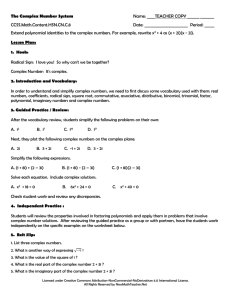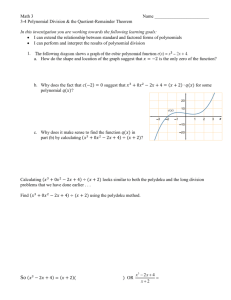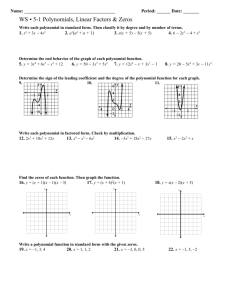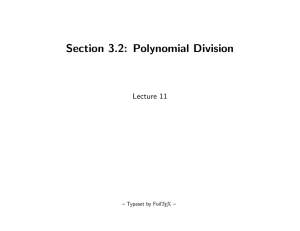3-4 Polynomial Division & Q
advertisement
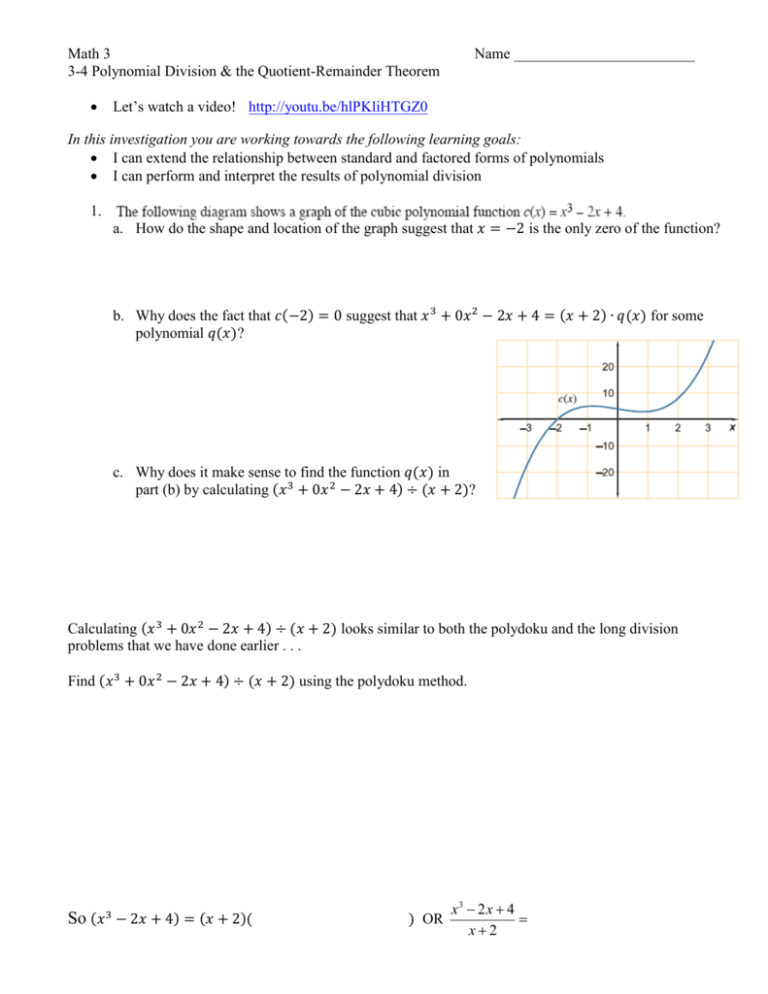
Math 3 3-4 Polynomial Division & the Quotient-Remainder Theorem Name ________________________ Let’s watch a video! http://youtu.be/hlPKliHTGZ0 In this investigation you are working towards the following learning goals: I can extend the relationship between standard and factored forms of polynomials I can perform and interpret the results of polynomial division 1. a. How do the shape and location of the graph suggest that 𝑥 = −2 is the only zero of the function? b. Why does the fact that 𝑐(−2) = 0 suggest that 𝑥 3 + 0𝑥 2 − 2𝑥 + 4 = (𝑥 + 2) ∙ 𝑞(𝑥) for some polynomial 𝑞(𝑥)? c. Why does it make sense to find the function 𝑞(𝑥) in part (b) by calculating (𝑥 3 + 0𝑥 2 − 2𝑥 + 4) ÷ (𝑥 + 2)? Calculating (𝑥 3 + 0𝑥 2 − 2𝑥 + 4) ÷ (𝑥 + 2) looks similar to both the polydoku and the long division problems that we have done earlier . . . Find (𝑥 3 + 0𝑥 2 − 2𝑥 + 4) ÷ (𝑥 + 2) using the polydoku method. So (𝑥 3 − 2𝑥 + 4) = (𝑥 + 2)( x3 2 x 4 ) OR x2 Example Find (𝑥 3 − 2𝑥 + 4) ÷ (𝑥 + 2) using long division So (𝑥 3 − 2𝑥 + 4) = (𝑥 + 2)( ) OR x3 2 x 4 x2 So right about now you are problem asking “Why is writing the function 𝑥 3 − 2𝑥 + 4 in the form (𝑥 + 2)( ) so important? Good question! We will answer that question eventually (in a later section), but for now we need to focus on writing polynomials in equivalent forms, given one real zero. So let’s practice! 2. a. s x x3 2 x 2 4 x 7 b. t x x4 2 x3 2 x2 17 x 42 SHOW ALL WORK BELOW: a.) Zero at x = _____ b.) Zero at x = _____ x3 2 x 2 4 x 7 x 4 2 x3 2 x 2 17 x 42 OR x3 2 x 2 4 x 7 OR x 4 2 x3 2 x 2 17 x 42 3. SHOW ALL WORK BELOW: a.) b.) x3 5 x 2 4 x 20 x3 2 x 2 4 x 7 OR x3 5 x 2 4 x 20 OR x3 2 x 2 4 x 7 4. Perform the following polynomial division a. 3x 3 17 x 2 10 x x 2 5 x b. 3x 5 6 x 4 2 x3 2 x 2 3x 1 x 3 x 2 1 PROBLEM 4 CONTINUED ON NEXT PAGE c. 5. 2x 5 6 x 4 4 x 3 12 x 2 3x 7 x 2 3x How is the division in problem (4) different from in problem (3)? Quotient-Remainder Theorem: If 𝑝(𝑥) is a polynomial and 𝑑(𝑥) is a nonzero polynomial, then there exist unique polynomials 𝑞(𝑥) and 𝑟(𝑥) such that for all numbers x, (1) 𝑝(𝑥) = 𝑞(𝑥) ∙ 𝑑(𝑥) + 𝑟(𝑥) (2) Either degree of 𝑟(𝑥) < degree of 𝑑(𝑥) Or 𝑟(𝑥) is the zero polynomial. The polynomial 𝑞(𝑥) is called the quotient and 𝑟(𝑥) is called the remainder for the division of 𝑝(𝑥) by 𝑑(𝑥).





